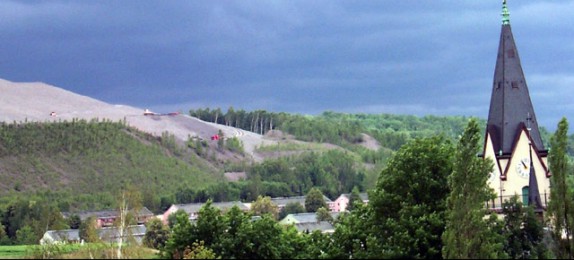
Ronneburg Mining District
The Wismut mining company was responsible for the development and operation of the East-German uranium mines under Russian control from the 1940s to reunification in 1989. During this period these mines employed up to 100,000 people and were responsible for the production of about one third of the Soviet blocks uranium production. The extent of the area affected by the former mining and ore processing activities is approximately 35 km2, of which 1,100 hectares (2,650 acres) are covered by waste rock piles, 700 hectares (1,700 acres) by tailings ponds and 3,480 hectares (8,352 acres) by the facilities. The majority of the mine workings and waste rock piles are acid generating and all wastes and disturbed areas are of environmental concern because of risks of metals leaching and radiation. Immediately following unification of Germany, the mining operations were discontinued and a fund of approximately 13 billion DM (10 billion US dollars) was provided for the clean-up and remediation of the uranium mining areas at an expenditure value of about 1 billion DM per year. This makes it the single biggest mining rehabilitation project in the world.
Dr. Robertson has acted as an advisor and study leader for numerous investigations, evaluations and designs for various aspects of the mine’s remediation, initially as the Project Principal and Senior technical leader for SRK studies and since 1995 on behalf of RGC. Earlier studies complied a review of the entire Ronneburg mining complex data and the development of a comprehensive water balance and geochemical balance for the entire area to allow alternative long term remediation and contaminant release strategies to be developed and their effectiveness assessed. This study resulted in the development of a number of new “control” concepts including the C zone concept and the potential of developing a hydraulic cage.
This was followed by a detailed program for the geochemical characterization of the acid generating waste dumps which included the development of drilling and test pitting programs (performed by Wismut personnel), logging and field characterization methods development, laboratory testing program definition, including new protocols for both static and kinetic testing of several hundred large scale columns. The results of these investigations were used to define the waste rock types and geochemical and engineering properties and to develop a system for prioritizing those that should be placed in the various secure zones within the Ronneberg open pit, hence the schedule and method of waste re-location.
Most recently RGC was appointed by Wismut to develop the methods and technology for the placement of cover layers on the very soft (weak) tailings in the pond zone of the Helmsdorf tailings impoundment. These extremely weak (essentially fluid) tailings require special techniques to increase their consolidation sufficiently to enable conventional cover placement techniques to be used. This study involved the use of finite strain consolidation theory to develop a model which predicts the rates of consolidation and pore pressure dissipation within the slimes zone under self weight as well as the incumbent loads of cover layers and placing equipment. The effects of short and long band drains were modelled for both short and long term effects. Available computer codes were not able to perform the modelling, and additional model development had to be done for the project. The study resulted in the development of alternative cover placement methodologies and the demonstration of the analytical methods for their design.
RGC also participated (with Wismut and other Wismut consultants) in the development of risk analyses for alternative tailings remediation methods to enable the alternative which provided the best long term cost benefits to be identified and to provide a rational for alternative selection.
Services Provided
- Data review and the development of a comprehensive water balance and geochemical balance for development and assessment of alternative long term remediation and contaminant release strategies
- Development of drilling and test pitting programs, and development of logging and field characterization methods, laboratory testing program definitions for the geochemical characterization of acid generating waste rock dumps for strategic relocation
- Develop the methods and technology for the placement of cover layers on the very soft (weak) tailings
- Development of risk analyses for alternative tailings remediation methods
Papers:
Jakubick, A.T., Gatzweiler, R., Mager, D., and Robertson, A. MacG. (1997) The Wismut Waste Rock Pile Remediation Program of the Ronnenburg Mining District, Germany. In: Fourth International Conference on Acid Rock Drainage, May 31 to June 6, 1997. Vancouver, B.C., Canada, p. 1285 – 1301.
Clients
Wismut GmbH
Related Services
